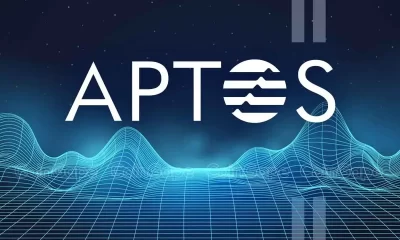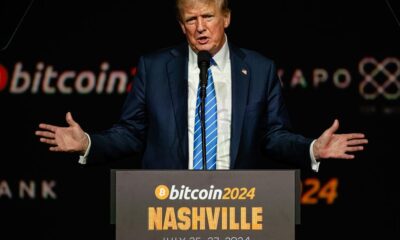Opinion
Syria Exploring The Embrace of Bitcoin
Published
2 months agoon
By
admin

Syria’s economy is in a bad state, to put it very mildly. Not only has the Middle Eastern nation been battered by over a decade of war, the Assad regime, which has been in power since 1971, has now been overthrown by a jihadist group. The conflict, which began in 2011, has devastated infrastructure, displaced millions, and led to economic sanctions from Western nations. These factors have crippled the local economy and trade, leading to severe inflation. The Syrian pound (SYP), which was once relatively stable, has lost over 99% of its value since the war began whilst hyperinflation has turned basic goods, like bread and fuel, into luxuries for ordinary citizens.
In the face of these challenges, Syria has struggled to maintain monetary stability, with dwindling foreign currency reserves and limited access to global financial systems. However, hope may now be on the horizon since it has been announced that the Middle Eastern nation is planning to legalise Bitcoin, explore using it to back its national currency and use its energy reserves to mine it. This ground-breaking policy could transform not only Syria’s economy but serve as a potential model for other nations in the region that are also grappling with inflation and economic instability.
Bitcoin’s decentralized nature makes it immune to geopolitical pressures and the monetary policies of individual nations. This independence offers Syria a way to circumvent traditional financial systems dominated by Western powers and sanctions. Legalizing Bitcoin, and potentially backing the Syrian pound with it, will not only facilitate monetary stability but will do so in a manner that allows the struggling nation to become somewhat immune from regional economic shocks. Bitcoin could also allow citizens and businesses to transact with greater confidence and open up trade channels with countries around the world.
This does make one wonder, localised fiat systems were never a good way to cultivate trade and commerce in the Middle East, where many nations are heavily reliant on each other for basic goods and services and where borders can be porous. Many of these systems are also pegged to the US dollar which does offer a degree of stability but it also allows the US to export its inflation. The region has a long history of trade that relied on gold, since it was widely accepted and recognised as a sound store of value. Bitcoin can now play that role, as it is increasingly recognised as the best store of value and medium of exchange in the world. Bitcoin, like gold, is also much more in-tune with Islamic monetary principles, as I wrote about here.
Furthermore, Syria possesses significant energy reserves, particularly in oil and natural gas. However, due to the war, much of this potential has been untapped or disrupted. In recent years, global energy-intensive Bitcoin mining has demonstrated that regions with surplus energy resources can transform these assets into significant revenue streams. Syria’s plan to use its energy reserves to mine Bitcoin is both practical and innovative. By converting its natural resources into digital assets, Syria can generate wealth independent of traditional export markets. This revenue could then be used to bolster its economy, fund reconstruction projects, and stabilize the Syrian pound by creating Bitcoin-backed reserves. It also gives an incentive for small businesses to explore and invest in mining technology, which can lead to innovation in sustainable energy production and bolster the local economy.
One of the core objectives of Syria’s Bitcoin strategy is to restore trust in its national currency. By partially backing the Syrian pound with Bitcoin, the government can offer citizens a tangible reason to hold and use the local currency. A Bitcoin-backed pound could also attract foreign investment, particularly from tech-savvy individuals and organizations intrigued by the country’s adoption of the digital currency. Such a move also aligns with global trends. El Salvador, for instance, adopted Bitcoin as legal tender in 2021 and saw an increase in tourism and investment, despite initial scepticism. While Syria’s situation is more complex due to ongoing conflict and questions around the ideological inclinations of its new leaders, a similar strategy could yield long-term benefits once the country stabilises.
Syria is not alone in facing inflation and currency devaluation. Many countries in the Middle East and North Africa (MENA) region are grappling with similar issues. Lebanon, for example, has experienced a catastrophic financial collapse, with its currency losing over 95% of its value since 2019. Inflation across the region has eroded purchasing power, undermined trust in local currencies, and hindered economic growth. Governments reliant on imports have found it increasingly difficult to stabilize their economies as global commodity prices soar.
Syria’s legalization of Bitcoin and its plan to integrate it into its economy marks a significant turning point in global financial policy. The decentralised nature of Bitcoin gives nations the option to pursue financial empowerment in spite of the wider international context in which they find themselves in. It gives them a form of national self-custody which can act as a hedge against external powers seeking to influence domestic policy in their favour. Whilst challenges remain, such as the need for a better digital infrastructure and wider awareness of Bitcoin in neighbouring countries, it is certainly a bold step in the right direction.
If successful, Syria’s experiment could serve as a blueprint for other nations in the MENA region facing economic instability. By adopting Bitcoin, these nations can protect their citizens from the devastating effects of inflation, restore confidence in their currencies, and unlock new economic opportunities. Countries like Lebanon, Iraq, and Iran, which face similar challenges, could benefit tremendously from integrating Bitcoin into their financial systems. As the global financial landscape continues to evolve, Syria’s bold move into Bitcoin highlights the potential of Bitcoin to address some of the most pressing economic challenges of our time.
This is a guest post by Ghaffar Hussain. Opinions expressed are entirely their own and do not necessarily reflect those of BTC Inc or Bitcoin Magazine.
Source link
You may like


Elon Musk Folds X Into xAI, Creating a $113 Billion Juggernaut


Why Trump’s ‘Liberation Day’ tariffs may hurt crypto’s global future


Top 4 Crypto to Buy Now as XRP Price Struggles above $2


US regulators FDIC and CFTC ease crypto restrictions for banks, derivatives


US Authorities Seize $201,400 Worth of USDT Held in Crypto Wallets Allegedly Intended to Support Hamas


Is Bitcoin’s Bull Market Truly Back?
Bitcoin
Why Trump’s ‘Liberation Day’ tariffs may hurt crypto’s global future
Published
53 minutes agoon
March 29, 2025By
admin

Donald Trump’s upcoming “Liberation Day” tariff announcement is being framed by some experts as a reset of global trade and could have negative implications for crypto.
While much of the attention is focused on the political fallout and trade disruptions, the broader consequences for digital assets, and the global frameworks that support them, deserve a closer look.
Heidi Crebo-Rediker, senior fellow at the Council on Foreign Relations, recently described on Bloomberg TV U.S. President Donald Trump’s plans as a “tearing up” of existing free trade agreements with America’s closest allies. This includes the so-called “Dirty 15”, a group of major trading partners that together make up 80% of U.S. trade.
Trump’s proposed system, built on unilateral tariffs and non-tariff barriers, represents a complete shift away from the cooperative global order that has defined the last several decades of international trade.
Why does this matter for crypto?
Crypto is inherently cross-border. Its infrastructure, users, capital flows, and regulatory frameworks depend on global alignment and relatively open markets. Any shift toward economic fragmentation risks disrupting that progress.
Crebo-Rediker notes that countries like Canada are already preparing to diversify away from the U.S., bracing for a reconfiguration of trade and investment relationships. In this new era, markets could become more closed, regulation more inconsistent, and capital controls more common.
She may agree (I don’t know), but these are all hostile conditions for crypto adoption. She also warns of a broader retreat from the multilateral frameworks that underpin both global finance and regulatory cooperation.
If America turns inward while allies look elsewhere, especially towards China, which is positioning itself as a defender of the global system – it could weaken the West’s influence over digital asset standards.
Crypto advocates have cheered Trump’s recent embrace of stablecoins and digital finance, but they should be cautious. A fragmented world, with each country pulling in a different direction on trade and tech, is not a world where crypto can thrive.
Forget about Michael Saylor’s vision of Bitcoin surpassing a $200 trillion market cap and we can only hope it can hold on to a $1 trillion valuation.
If global coordination erodes, so too might the prospects for crypto’s next wave of adoption. If so, it was a fun run. If not, I’ll be glad to admit being wrong.
Source link

The synergy of political endorsement and highly speculative assets like meme coins was always bound to be disastrous, and the recent LIBRA scandal was a clear reflection of this concern.
Crypto has come a long way over the past decade. Mainstream adoption, institutional interest, and regulatory clarity helped the industry gain increasing credibility. And meme coins also carved out an exciting niche in this sector, which reflected creativity and community engagement. Yet, political meme coins could ruin this decades-worth of progress very quickly.
A promotional post from Argentina’s president, Javier Milei, caused LIBRA investors to lose over $250 million in just hours. His endorsement sparked a buying frenzy that pushed the price from near zero to almost $5 in a matter of minutes. Insiders quickly cashed out, dumping over $107 million in tokens before the price collapsed. Argentina’s fintech chamber labeled this classic rug pull without mincing words.
The Anatomy of a Meme Coin Scam
Unfortunately, the LIBRA scandal was not an exceptional case. Bubblemap analysts traced LIBRA’s origins back to the team behind the MELANIA token and other pump-and-dump schemes. The same group launched several coins that swelled in price before crashing.
President Milei, a self-proclaimed libertarian and Bitcoin enthusiast, used his platform to share information about LIBRA. His tweet ignited a rush among investors eager to capitalize on his reputation.
It’s still staggering that influential figures have yet to understand the true impact of their statements on an industry largely driven by speculative interest. As the token’s value soared, insiders began unloading their tokens. Within hours, the coin’s market cap fell from $4.5 billion to just a fraction of that amount.
However, on-chain analysis shows that LIBRA was fundamentally designed to potentially scam investors. The founders held 70% of the token supply, which allowed them to profit massively while leaving retail investors vulnerable. When insiders cashed out, many traders lost nearly everything they had invested.
Such pump-and-dump schemes always follow the same playbook: a high-profile personality sparks investor interest, insiders pocket their profits, and the token collapses. This pattern played out with LIBRA in a textbook fashion.
Political Endorsements and Market Manipulation
Political endorsements used in these schemes add a disturbing twist to the story. Milei’s tweet did more than spread a message; it lent credibility to a high-risk asset. When a sitting president supports a project, many assume there is underlying merit. This assumption helped drive the buying frenzy around LIBRA. Similar episodes occurred in the United States with the TRUMP and MELANIA tokens. Politically-linked meme coins have morphed from mere speculative plays into tools for financial manipulation.
Galaxy Research Analyst Alex Thorn describes LIBRA as the latest example of a series of Solana-based meme coin implosions. During this crash, Solana’s transaction volumes plummeted to mid-2024 levels, and there is growing concern over a $1.5 billion FTX token unlock. These factors combine to put additional pressure on Solana’s price.
Meme coins, which dominated headlines in 2024, now face harsh market realities in 2025. Many of these tokens have already lost 30-60% of their value. Activity on platforms such as Pump.fun has cratered, and overall trading volume in the sector is in freefall.
The trend of politically-endorsed tokens creates an environment where hype easily overrides fundamentals. Political figures lend their names to projects with little oversight. This practice allows groups of insiders to generate large profits at the expense of everyday investors.
The situation exposes a troubling trend in crypto markets. When prominent figures use their influence to spark buying frenzies, they turn volatile tokens into weapons for financial manipulation. Such practices risk undermining trust in the entire crypto ecosystem.
A Much-Needed End to the Chaotic Meme Coin Cycle?
The $LIBRA debacle should serve as a harsh lesson for retail investors. Many of those who lost money had a high level of technical knowledge, as they needed Solana wallets and SOL tokens to participate.
However, the overall appeal of politically charged tokens often attracts investors who believe that an endorsement from a political heavyweight guarantees success. Reality proved otherwise. When high-profile insiders exploit their inside knowledge to exit early, the outcome is disastrous for retail participants.
As institutional investors shift their focus to more stable markets like Bitcoin and Ethereum ETFs, the appetite for meme coins might be waning. Political meme coins remain the lawless frontier of crypto. Their volatile nature and inherent manipulation make them a poor choice for risk-averse investors. The recent fallout suggests that market excitement has finally run far ahead of sound fundamentals.
Political meme coins represent a clear symptom of a larger problem. They expose vulnerabilities in a market that still lacks a solid regulatory framework. When the excitement around a meme coin overshadows careful analysis, the consequences can be severe. Investors may see short-term gains, but the inevitable collapse brings long-term damage. The case of $LIBRA proves that political endorsements do not safeguard against market manipulation.
Source link


Right now, my X feed is full of people who are giving up on Web3 gaming. I get it. Over $12 billion of venture capital funding has gone into it since 2020 and they haven’t seen the sort of breakout success that many expected. Even the best games haven’t reached anything close to mainstream scale. Token prices are down. Studios are shutting down. And everyone is exhausted.
But measuring Web3 gaming by token prices alone is like calling the internet a failure because of the dot-com crash — it ignores how far the technology has come and where it’s headed. It’s missing the real story.
At its core, Web3 gaming is about giving players real ownership — not just of the in-game items that they buy and earn, but also their identities and achievements. In traditional games, players invest time, effort and money into digital assets that ultimately belong to the publisher. Web3 changes that. By putting assets on-chain, players can truly own what they earn—whether that’s tradable items like weapons or land, or non-transferable badges of reputation, guild history, or verifiable skill. It’s not just about buying and selling stuff — it’s about agency, persistence, and getting proper recognition for what you’ve built and what is really yours in the ecosystem.
The concept isn’t new. Players have wanted more control over their in-game assets for years. Look at the massive markets for CS:GO skins or World of Warcraft gold. But until now, those economies have been fragmented, restricted, or at risk of being shut down if a centralized publisher decides to shut it down or change the rules. Web3 makes these economies open, interoperable, player-owned and player-driven.
Ownership has always been the foundation of Web3 gaming, and play-to-earn was an experimental model that showed the potential for open and permissionless virtual economies on blockchain. Now, the industry is evolving with a stronger focus on sustainable economies and better tokenomics, deeper gameplay, and long-term player engagement.
But if you’re comparing Web3 gaming to Web2 gaming, you’ll be disappointed. Traditional gaming has had decades to fine-tune game design, build massive player bases, and develop business models that work, while Web3 gaming is still in its experimental phase. Sure, billions of dollars of investment can speed things up, but throwing money at a brand new category doesn’t magically buy it a track record or instantly create new games that people love.
I’ve been making games for over 20 years and I have seen every major shift get dismissed before it took over. Nobody believed mobile gaming could compete with PCs or consoles until it became bigger than both. Free-to-play was called a scam until it made more money and reached more players than ever before. Esports was a joke until stadiums sold out and prize pools hit millions. Digital skins were “worthless” before they became a multi-billion dollar market.
And now, Web3 gaming is at that same inflection point.
When I first heard about blockchain in 2018, everyone I knew in FinTech was talking about it. So of course I thought it was boring and I ignored it. It wasn’t until I learned about CryptoKitties that I actually took notice. When I saw people collecting, trading and actually owning these cute on-chain cats, that’s when I got excited because I knew they weren’t like other in-game assets. CryptoKitties were digital things that no one could take away from you. As someone who’s spent their life grinding in games, and their career convincing others to grind the same — without really getting anything for it — that idea of digital ownership gave me a whole new way to think.
So I went all-in on blockchain games. But 2018 and 2019 were really tough times. Pretty much no one else cared back then. There was no support, no real funding, no clear idea of what these games could be beyond speculation, and (outside of a handful of believers) there was very little conviction. The market was in a deep bear cycle, and many teams either gave up or ran out of money before they could launch. Still, some of us kept building. We stayed lean, experimented, and learned everything the hard way. It feels similarly bad now, but not as bad as it was then. Looking back, I’m so glad we didn’t pack it in when success was just around the corner.
When Axie Infinity broke through in 2021, everything changed. Web3 founders like Jeffrey “Jihoz” Zirlin of Sky Mavis, Yat Siu of Animoca Brands, Sebastien Borget of The Sandbox, and me, went from being called crazy to visionary overnight. Suddenly, we were speaking on the main stage at conferences where we used to watch in the audience. We made news headlines and “Most Influential” lists. Investors who ignored our emails were asking how much they could put in. My email inbox filled up with fundraising decks pitching the next YGG.
Then in 2022, the market crashed, and just as quickly, we went back to being crazy. But that never really bothered me because crazy people are the ones who make big things happen.
Now, everyone’s asking: When is the next big Web3 game? The answer is this: good games take time. And if you look past the red candles to take notice of what exists already today, you’ll see we how much progress we’ve made since our industry was seeded in 2018:
- In 2020, Axie Infinity had fewer than 500 daily players. Today, Ronin — the blockchain it built — has millions of active users, with 17 new games launched, and 134% growth in NFT trading volume in 2024 compared to 2023. It’s also gone permissionless, which means there will be more games, faster development, stronger network effects, and unpredictably big breakthroughs. Some of the biggest innovations in gaming like modding, free-to-play and esports came from unexpected places. By lowering the barrier to entry, a permissionless Ronin invites the kind of experimentation that could lead to the next Axie-scale success.
- Pixels, a farming game on Ronin, hit a peak of 1.3 million daily active users (DAUs) and is holding strong now with around 250,000 DAUs even with its token down 96%. Players are spending more than they cash out, buying land, upgrading assets, and actually putting money back into the game, fueling the economy instead of extracting from it. This is how virtual economies should work, with real demand and strong retention. Most importantly, it is an indication that the play-to-earn model can work if done right.
- Parallel, a trading card game (TCG) on Ethereum, just hosted a world championship in Las Vegas at the HyperX Arena — a venue that has hosted some of the biggest esports competitions from “League of Legends All-Stars” to “Street Fighter V’s Capcom Cup.” This was a prestigious event that saw some of the world’s best TCG players crossover from traditional titles like Hearthstone to become some of the first Web3 esports legends.
These are just a few examples, but they show the kind of traction we’re seeing: better infrastructure, growing communities, more sustainable virtual economies, digital ownership.
Those who FUD Web3 gaming today don’t understand it. They missed CryptoKitties in 2018, Axie in 2020, YGG in 2021, and they’ll miss the next wave too because they’re measuring the wrong metrics. Web3 is growing and innovating faster than any other sector in gaming. It’s not time to quit. It’s time to double down. Let them call us whatever they want: crazy, delusional. Visionary, pioneering. It doesn’t change what we do. We’ve been here before. Stay the path.
Source link

Elon Musk Folds X Into xAI, Creating a $113 Billion Juggernaut

Why Trump’s ‘Liberation Day’ tariffs may hurt crypto’s global future
Bitcoin Plunges Below $84K as Crypto Sell-Off Wipes Out Weekly Gains

Top 4 Crypto to Buy Now as XRP Price Struggles above $2
Ethereum Price Hits 300-Week MA For The Second Time Ever, Here’s What Happened In 2022

US regulators FDIC and CFTC ease crypto restrictions for banks, derivatives

US Authorities Seize $201,400 Worth of USDT Held in Crypto Wallets Allegedly Intended to Support Hamas

Is Bitcoin’s Bull Market Truly Back?

Stablecoin Bills Unfairly Box Out Foreign Issuers Like Tether, Says House Majority Whip

THORChain price prediction | Is THORChain a good investment?

Strategy (MSTR) Holders Might be at Risk From Michael Saylor’s Financial Wizardry

3 Altcoins to Sell Before March 31 to Prepare for Crypto Bull Market

A Big Idea Whose Time Has Finally Come

XRP price may drop another 40% as Trump tariffs spook risk traders

Trader Says Ethereum-Based Altcoin Primed for 240%+ Rally if Major Resistance Level Breaks, Updates XRP Outlook

Arthur Hayes, Murad’s Prediction For Meme Coins, AI & DeFi Coins For 2025

Expert Sees Bitcoin Dipping To $50K While Bullish Signs Persist

Aptos Leverages Chainlink To Enhance Scalability and Data Access

Bitcoin Could Rally to $80,000 on the Eve of US Elections

Sonic Now ‘Golden Standard’ of Layer-2s After Scaling Transactions to 16,000+ per Second, Says Andre Cronje

Institutional Investors Go All In on Crypto as 57% Plan to Boost Allocations as Bull Run Heats Up, Sygnum Survey Reveals

Crypto’s Big Trump Gamble Is Risky

Ripple-SEC Case Ends, But These 3 Rivals Could Jump 500x

Has The Bitcoin Price Already Peaked?

A16z-backed Espresso announces mainnet launch of core product

Xmas Altcoin Rally Insights by BNM Agent I

Blockchain groups challenge new broker reporting rule

Trump’s Coin Is About As Revolutionary As OneCoin

The Future of Bitcoin: Scaling, Institutional Adoption, and Strategic Reserves with Rich Rines

Is $200,000 a Realistic Bitcoin Price Target for This Cycle?
Trending

 24/7 Cryptocurrency News5 months ago
24/7 Cryptocurrency News5 months agoArthur Hayes, Murad’s Prediction For Meme Coins, AI & DeFi Coins For 2025

 Bitcoin2 months ago
Bitcoin2 months agoExpert Sees Bitcoin Dipping To $50K While Bullish Signs Persist

 24/7 Cryptocurrency News3 months ago
24/7 Cryptocurrency News3 months agoAptos Leverages Chainlink To Enhance Scalability and Data Access

 Bitcoin5 months ago
Bitcoin5 months agoBitcoin Could Rally to $80,000 on the Eve of US Elections

 Altcoins2 months ago
Altcoins2 months agoSonic Now ‘Golden Standard’ of Layer-2s After Scaling Transactions to 16,000+ per Second, Says Andre Cronje

 Bitcoin4 months ago
Bitcoin4 months agoInstitutional Investors Go All In on Crypto as 57% Plan to Boost Allocations as Bull Run Heats Up, Sygnum Survey Reveals

 Opinion5 months ago
Opinion5 months agoCrypto’s Big Trump Gamble Is Risky

 Price analysis5 months ago
Price analysis5 months agoRipple-SEC Case Ends, But These 3 Rivals Could Jump 500x


